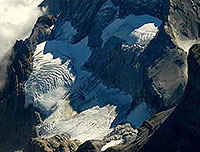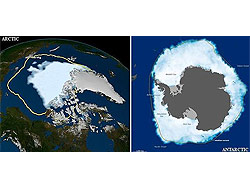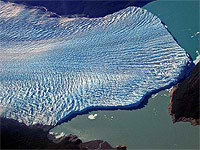Esa es la conclusión a la que han llegado científicos de la Universidad de Cantabria, de la Autónoma de Madrid y de Valladolid, tras realizar una síntesis del estado actual de los glaciares que existen en la geografía española, los Pirineos, Picos de Europa y Sierra Nevada, observando la evolución climática desde la Pequeña Edad del Hielo – entre el año 1300 y 1860- hasta el periodo actual.
La razón de estudiar a través de los glaciares los efectos del cambio climático la ofrece el investigador jefe del estudio, Juan José González Trueba: “Las altas montañas son espacios especialmente sensibles a los cambios climáticos y ambientales, y dentro de esllas, la evolución de los glaciares es uno de los indicadores más eficientes que evidencia el calentamiento global que estamos viviendo”.
Actualmente, en la cordillera pirenaica quedan 21 glaciares, 10 en la vertiente española y 11 en la francesa. El estudio pone en evidencia que hasta la fecha han desaparecido todos los glaciares pequeños y los de superficie más grandes, “han menguado su superficie entre un 50 y un 60%”. Aunque no siempre ha sido así, ya que según se desprende de la investigación, “entre 1645 y 1710 se dio en la península un periodo más frío, haciendo que los glaciares de las altas montañas crecieran.
Noticia completa en Pirineo Digital (España)
Enlaces a sitios |
| |
Climbing Magazine Climbing Magazine"s Web site contains more than 30 years of rock and ice climbing news, climber profiles, technical information, and gear reviews. You"ll also find message boards, photo galleries, and classifieds
| Cold Regions Bibliography Between 1999 and 2000, this project was carried out under an Interagency Agreement between the Federal Research Division of the Library of Congress and the U.S. Army Cold Regions Research and Engineering Laboratory (CRREL).
|
Descent into the Ice A tem of "glacionauts" ventures into a labyrinth of unexplored anda hazardous glacier caves on France"s Mont Blanc
| Glacier and Permafrost Hazards in Mountains – GAPHAZ Scientific Working Group of the International Association of Cryospheric Sciences (IACS) and the International Permafrost Association (IPA). Department of Geosciences University of Oslo
|
Glacier hazards The experience and data on glacier disasters in Switzerland has been systematically collected in the past two decades, and historical sources were analyzed.
| Glacier Hazards From Space Glacier hazards represent a continuous threat to human lives and infrastructure in mountain regions.
|
Glacier Hazards in Perú The floods, known in Perú as aluviónes, come with little or no warning and are composed of liquid mud that generally transports large rock boulders and blocks of ice.
| Glaciers and Glacier Hazards Glaciers and Glacier Hazards Glaciers and Ice Sheets and Volcanic Eruptions, USGS/Cascades Volcano Observatory, Vancouver, Washington
|
Glaciers online Glaciers online offers photos and summary explanations concerning glaciers from all over the world. The primary goal of our project is to enrich and stimulate the teaching of Earth Science and Physical Geography, in particular glaciology.. Jürg Alean & Mi
| Global Land Ice Measurements from Space GLIMS (Global Land Ice Measurements from Space) is a project designed to monitor the world"s glaciers primarily using data from optical satellite instruments, such as ASTER (Advanced Spaceborne Thermal Emission and reflection Radiometer).
|











 Imagen: Agencias / Internet
Imagen: Agencias / Internet





